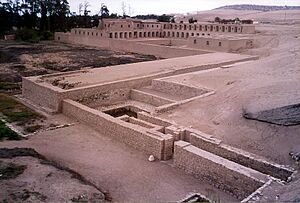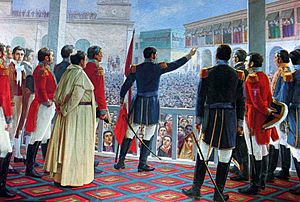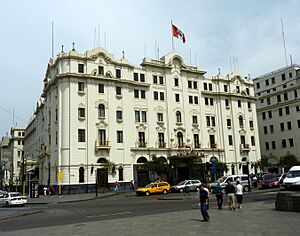History of Lima facts for kids
The history of Lima tells the story of Peru's capital city. It all started when Francisco Pizarro founded the city on January 18, 1535. Lima was built in the Rímac River valley, an area where the Ichma people lived. It quickly became the main city of the Viceroyalty of Peru and a very important place for the Spanish government. In the 1600s, Lima grew rich from trade, even with earthquakes and pirates around. But in the 1700s, things slowed down because of money problems and new rules from Spain.
Lima's people had mixed feelings during the Peruvian War of Independence (1821–1824). The city suffered from both sides fighting. After Peru became independent, Lima became its capital. It had a good time in the mid-1800s. But then the War of the Pacific (1879–1883) happened. Chilean soldiers took over and looted the city. After the war, Lima grew a lot. More people moved there, especially from the mountains, starting in the 1940s. This led to many new neighborhoods, but public services struggled to keep up.
Contents
Founding Lima: A New Capital

Before the Spanish came, the area where Lima is now was home to several native groups. The Ichma people lived in the valleys of the Rímac and Lurín rivers. They built about 40 pyramids linked to their farming systems.
In 1532, Spanish conquistadors led by Francisco Pizarro captured the Inca ruler Atahualpa. Pizarro then looked for a good place to build his capital. His first choice was Jauja in the Andes mountains. But it was too high up and far from the sea. Spanish explorers found a better spot in the Rímac valley. It was near the Pacific Ocean, had plenty of water and wood, good land, and nice weather. So, Pizarro founded the city of Lima on January 18, 1535. Carlos Huerta wrote about this in his book:
Foundation of Lima. The city capital of Peru was founded on 18 January and was called Ciudad de los Reyes (City of Kings) in honor of the feast of the holy kings who was celebrated. Began in the church, the foundation and the plane of the city, where Pizarro put the first stone.
In August 1536, Manco Inca, an Inca leader, led a rebellion. His troops attacked the new city. But the Spanish and their native allies, led by Pizarro, fought hard and defeated the rebels. On November 3, 1536, the Spanish King approved the city's founding. On December 7, 1537, King Charles V, Holy Roman Emperor gave Lima its own coat of arms.
Lima's Colonial Life and Growth
For many years, Lima faced problems from fights between different Spanish groups. But it also became very important. In 1543, it was made the capital of the Viceroyalty of Peru. This meant it was the center of Spanish rule in South America. Latin America's first university, the National University of San Marcos, opened in Lima in 1551. The first printing press arrived in 1584. Lima also became a major religious center. A Catholic diocese was set up in 1541, becoming an archdiocese five years later.
Lima thrived in the 1600s. It was the heart of a huge trade network. This network connected Peru with the Americas, Europe, and Asia. Merchants sent Peruvian silver through the nearby port of Callao. They traded it for goods from other countries at the Portobelo fair in Panama. All trade from the Viceroyalty had to go through Callao. This made Lima very rich. The city grew fast, from about 25,000 people in 1619 to around 80,000 in 1687.
However, Lima also faced dangers. On October 20 and December 2, 1687, strong earthquakes destroyed most of the city. Diseases and food shortages followed, cutting the population to under 40,000 by 1692. Pirates were another threat in the Pacific Ocean. A Dutch navy group attacked Callao in 1624 but was stopped. In the 1680s, English buccaneers (pirates) were common. Lima merchants eventually drove them away in 1690. To protect the city, Viceroy Melchor de Navarra y Rocafull built the Lima City Walls between 1684 and 1687.
The 1687 earthquake changed Lima's history. Trade slowed down, silver production dropped, and other cities like Buenos Aires started competing. On October 28, 1746, another huge earthquake hit. It badly damaged Lima and destroyed Callao. This led to a massive rebuilding effort led by Viceroy José Antonio Manso de Velasco. This disaster also led to a strong devotion to an image of Christ called The Lord of the Miracles. People have carried it in a procession every October since 1746.
In the late colonial period, new ideas about public health shaped Lima. New buildings included a place for cockfighting and a bullring, the Plaza de toros de Acho. A General Cemetery was also built. The first two helped control popular activities by putting them in one spot. The cemetery stopped people from burying bodies in churches, which was seen as unhealthy.
Lima's Fight for Independence
In the late 1700s, Lima was hurt by new Spanish rules called the Bourbon Reforms. It lost its special control over overseas trade. An important mining area was also moved to another Spanish territory. This made Lima's rich families rely on jobs from the King or the Church. So, they were not eager for independence. In the 1810s, Lima became a strong base for the Spanish King's supporters during the South American wars of independence.
A group of soldiers from Argentina and Chile, led by General José de San Martín, landed south of Lima on September 7, 1820. But they did not attack the city right away. The Spanish Viceroy José de la Serna had to leave Lima in July 1821. He wanted to save his army because of a naval blockade and attacks from local fighters. The city council was worried about a rebellion. They asked San Martín to enter Lima and signed a Declaration of Independence for Peru. But the war was not over. For the next two years, Lima was taken by different armies. It suffered a lot from both sides. By the time the war ended with the Battle of Ayacucho on December 9, 1824, Lima was very poor.
Lima in the Republic Era
After independence, Lima became the capital of the new Republic of Peru. But the economy was bad, and there was political chaos. This stopped the city from growing for a while. Things changed in the 1850s. Peru started earning a lot of money from selling guano (bird droppings used as fertilizer). This led to fast growth in Lima. Over the next 20 years, the government built many large public buildings. These replaced older colonial ones. Examples include the Central Market, a slaughterhouse, a mental hospital, a prison, and the Dos de Mayo Hospital.
Transportation also improved. A railroad line between Lima and Callao was finished in 1850. The Balta Bridge, an iron bridge over the Rímac River, opened in 1870. The city walls were even torn down in 1872 because people expected the city to keep growing. However, this economic boom also made the gap between rich and poor wider, causing social problems.
During the War of the Pacific (1879–1883), Chilean soldiers took over Lima. They had defeated Peruvian forces in the battles of San Juan and Miraflores. The city suffered greatly. The invaders looted public museums, libraries, and schools. At the same time, angry crowds attacked rich citizens and the Asian population. They stole from their homes and businesses.
After the war, Lima began to rebuild and expand from the 1890s to the 1920s. Downtown Lima was getting too crowded. So, the La Victoria area was created in 1896 as a neighborhood for working-class families. During this time, new, wide avenues were built. These roads crossed the city and connected it to nearby towns like Miraflores. In the 1920s and 1930s, several buildings in the historic center were rebuilt. These included the Government Palace and the Municipal Palace.
On May 24, 1940, an earthquake hit the city. Most buildings at that time were made of adobe (mud brick) and quincha (wattle and daub). In the 1940s, Lima started to grow very fast. Many people moved there from the Andean regions of Peru. The population was about 600,000 in 1940. It jumped to 1.9 million by 1960 and 4.8 million by 1980. At first, the city was a triangle between its historic center, Callao, and Chorrillos. In the following decades, new settlements spread north, east, and south. Immigrants, who first lived in downtown slums, led this expansion. They created many new neighborhoods, often called pueblos jóvenes (young towns). Major public works were done during this time, especially under the governments of Manuel A. Odría (1948–1956) and Juan Velasco Alvarado (1968–1975). A style of architecture called Brutalism was popular in the 1970s. The large headquarters for Petroperú, the state oil company, is an example. By the 1993 census, Lima's population reached 6.4 million. This was 28.4% of Peru's total population, compared to just 9.4% in 1940.
See also
 In Spanish: Historia de la ciudad de Lima para niños
In Spanish: Historia de la ciudad de Lima para niños
- Historic Centre of Lima
- History of Peru
- List of mayors of Lima
- Timeline of Lima






